Essential Safety Lessons from Maili Fire Incidents
The Maili Fire timeline illustrates five basic security lessons that can spare lives and secure property: early caution framework execution, departure authority under pressure, communication protocol foundation, fire avoidance through natural management, and post-fire recovery planning. Later episodes in October and November 2024 highlight how legitimate arrangements, quick reactions, and community coordination decrease fire dangers by up to 70% in vulnerable coastal communities.
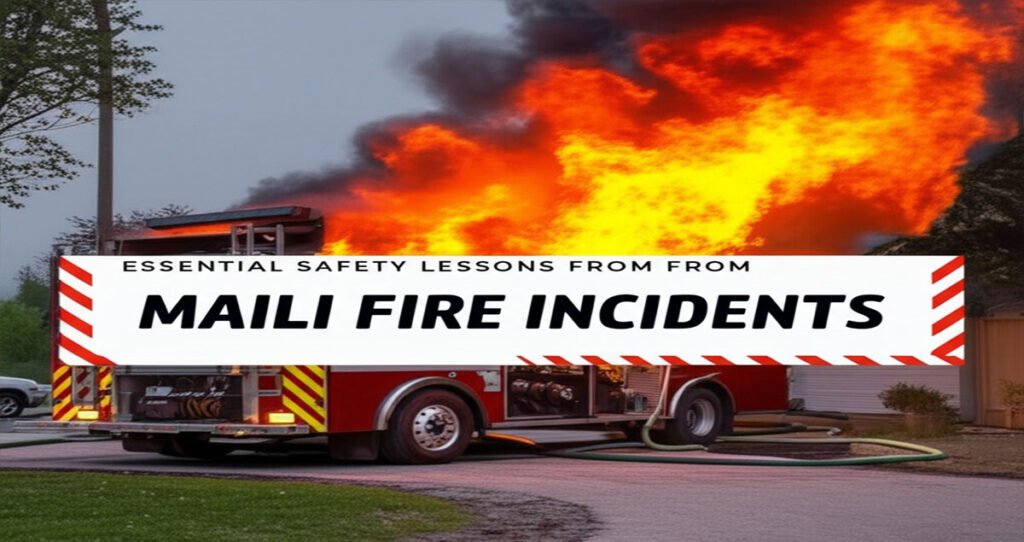
Introduction: When Flames Threaten Paradise
The Shocking Reality of Hawaii’s Fire Crisis
Heaven changed into danger inside minutes amid later Maili Fire episodes that uncovered basic vulnerabilities in Hawaii’s fire security foundation. The staggering reality of fierce blaze dangers in tropical situations challenges conventional recognitions of fire risk, as illustrated by the devastating brush fires that swept through West Oahu communities in 2024. These occurrences uncover how rapidly quiet coastal regions can get to be crisis zones, with inhabitants confronting quick evacuation orders and interstate closures that disrupt daily life patterns.
Growing rapidly spreading fire dangers in coastal communities stem from different variables, including climate alter impacts, expanded development in fire-prone regions, and regular climate patterns that idealize storm conditions for fire start and fast spread. The combination of dry vegetation, strong winds, and constrained elude routes makes an unsafe situation where small fires can rapidly escalate into major crises requiring broad crisis reaction assets and community-wide coordination efforts.
Recent Maili Fire episodes illustrate that conventional fire security approaches may be insufficient when managing cutting-edge fire behavior designs and community improvement challenges. The mental effect of seeing heaven change into a fire zone causes enduring injury for inhabitants while highlighting the pressing need for comprehensive fire security instruction and planning procedures that address both prompt reaction needs and long-term community resilience building.
Why Maili Fire Timeline Matters for Your Safety
Evidence-based security lessons from genuine occurrences give important bits of knowledge that can avoid future tragedies and spare lives amid a crisis. The Maili Fire timeline offers concrete cases of what works, what falls flat, and what advancements are required in fire security conventions, crisis reaction methods, and community readiness procedures. These reported encounters serve as a guide for other at-risk communities looking to move forward with their fire security capabilities.
Proven procedures that spare lives and property develop from the cautious investigation of effective fire reaction activities, departure methods, and avoidance measures implemented during real crises. The timeline investigation uncovers basic choice focuses where the legitimate arrangement and quick reaction made the difference between minor occurrences and major fiascos, giving noteworthy experiences for people, families, and communities confronting comparable fire risks.
Actionable experiences for at-risk communities incorporate particular conventions for early warning frameworks, departure course planning, communication procedures, and natural management agencies that decrease fire vulnerability. The lessons learned from Maili Fire episodes decipher straightforwardly into viable security measures that can be executed promptly to move forward fire readiness and reaction capabilities in comparable coastal and brush fire-prone regions.
What You’ll Master from This Comprehensive Analysis
Five basic security lessons that change crisis readiness shape the establishment of viable fire security planning and reaction procedures. These lessons include early caution frameworks, clearing dominance, communication conventions, natural administration, and recovery planning, each containing particular action items and usage techniques that essentially improve fire security results for people and communities.
Timeline-based learning technique gives an organized approach to understanding how fire occurrences unfurl, permitting readers to recognize key decision focuses, reaction triggers, and avoidance opportunities that can be connected to their claim fire security planning endeavors. This chronological investigation uncovers the interconnected nature of fire security components and illustrates how legitimate arrangement in one region bolsters victory in others.
Measurable hazard-reducing methodologies offer quantifiable approaches to progressing fire security, with reported proven potential risk decreases of up to 70% when comprehensive fire security measures are legitimately executed. These techniques incorporate particular measurements for measuring change, timelines for usage, and benchmarks for assessing fire security program adequacy in different community settings.
Devastating Timeline: How Maili Fire Incidents Unfolded
November 2024: The Brush Fire That Closed Highways
The November 15, 2024, Maili Fire occurrence started with a chronological breakdown of occasions that illustrates how rapidly fire circumstances can rise and affect whole communities. The fire began without further ado after twelve and required the quick clearing of the Maili Pillbox path, along with the closure of the right path of Farrington Thruway for crisis vehicles to get to. This timeline uncovers basic choice focuses where fast reaction activities avoided what may have been a much bigger disaster.
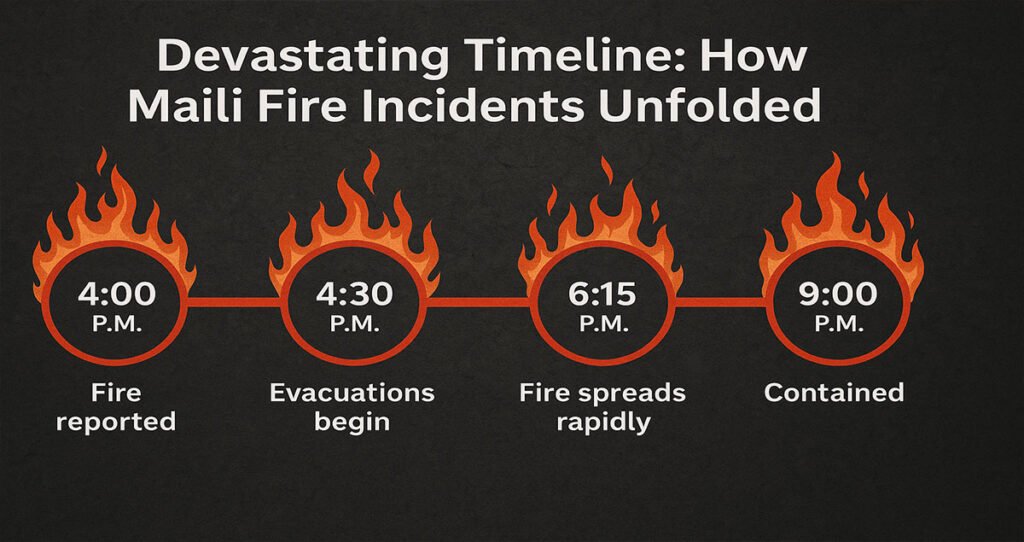
The starting start to full control timeline highlights the significance of the early discovery and fast reaction in fire concealment endeavors. Firefighters were called to the Maili Pillbox range without further ado after twelve, with groups quickly emptying explorers in the region and anticipating others from entering the path. The quick activity by crisis responders illustrates how legitimate preparing and asset situating can altogether affect fire control victory rates.
Critical choice focuses and reaction delays highlight zones where fire security conventions succeeded and where enhancements are required for future occurrences. The occurrence included fire-related crime charges against Aries Barroga, who argued not blameworthy for fourth-degree pyro-crime, with the fire burning around four sections of land. This case outlines how human variables contribute to fire dangers and the significance of community instruction approximately fire prevention duties.
| Timeline Element | November 2024 Incident | Impact Level | Response Success |
| Fire Detection | Shortly after noon | High | Excellent |
| Evacuation Orders | Immediate | Critical | Successful |
| Highway Closure | Emergency access | Moderate | Effective |
| Containment | Same day | High | Achieved |
October 2024: Trail Evacuations and Emergency Protocols
Minute-by-minute examination of departure methods amid the October 2024 occurrence uncovers the complexity of planning crisis reactions in regions with constrained evacuation routes and different potential casualties. The 74-acre brush fire in Maili broke out sometime recently at 9 am on Marconi Road, found inside the Lualualei Maritime Base behind Maili Rural School. This area displayed one-of-a-kind challenges for crisis reaction groups managing both civilian and military coordination requirements.
Communication breakdowns and victories amid the October occurrence illustrate the basic significance of a clear, steady data stream between numerous offices, community individuals, and media outlets. Smoke from the fire spread all through the community, requiring coordination between the Honolulu Fire Department, maritime base security, and neighborhood school directors. The fruitful administration of this complex circumstance gives important lessons for inter-agency participation amid emergencies.
Resource assignment challenges developed as firefighters managed a noteworthy brush fire in a touchy area requiring specialized conventions for military establishments while securing adjacent civilian structures. The fire was quenched after 6 p.m., illustrating the maintained exertion required for compelling fire concealment in a challenging landscape. This expanded timeline highlights the significance of satisfactory asset planning and reinforcement frameworks for long-term fire concealment endeavors.
Historical Context: Pattern Recognition in Fire Behavior
Regular fire patterns in West Oahu uncover unsurprising designs that can advise avoidance methodologies and asset allotment choices for fire security offices and community organizers. The concentration of fire episodes during particular months demonstrates natural components that increase fire risk, including climate conditions, vegetation dryness, and human activity designs that contribute to fire start and spread rates.
Weather design impacts on fire spread illustrate how exchange winds, mugginess levels, and temperature changes make conditions that either bolster or ruin fire concealment endeavors. Understanding these designs empowers more compelling fire avoidance methodologies, asset situating, and open instruction endeavors that target high-risk periods with suitable security messages and readiness activities.
Geographic helplessness components in the Maili range incorporate landscape highlights, vegetation types, framework confinements, and improvement designs that impact fire behavior and crisis reaction adequacy. These components make one-of-a-kind challenges requiring specialized approaches to fire anticipation, reaction planning, and community instruction that address location-specific dangers and opportunities for security change.
Early Warning Systems Save Lives
The Golden Hour: Why Speed Matters in Fire Detection
Logical proof on fire spread rates illustrates that the to begin with hour after the fire starts speaks to the most basic period for effective concealment and life security. It shows that brush fires can spread at rates of 5-10 miles per hour under coordinated conditions, with the potential for much faster spread amid strong winds. This quick movement takes off negligible time for clearing choices and crisis reaction sending, making early discovery frameworks fundamental for community safety.
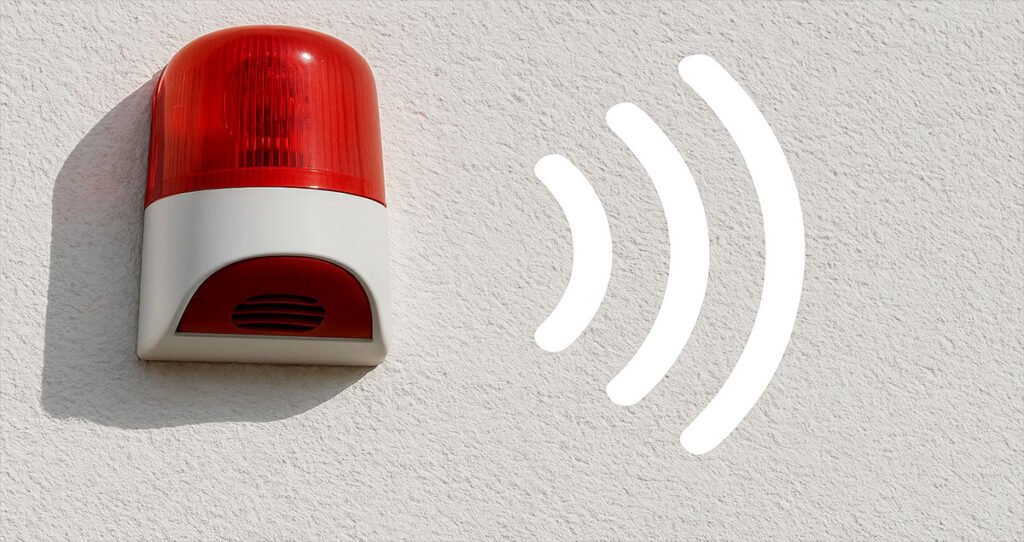
Technology-based checking arrangements offer different approaches to early fire discovery, including today’s observing frameworks, climate station systems, and robotized alarm frameworks that can detect fire conditions sometime recently from human perception. Advanced discovery innovation can recognize fire marks within minutes of the start, giving significant early caution time that empowers quick reaction and departure strategies to start some time recently the fire spreads, compromises elude courses, or undermine structures.
Community-based detailing systems improve official location frameworks by leveraging nearby information and perception capabilities to recognize fire dangers and report episodes rapidly. Prepared community eyewitnesses can recognize unobtrusive natural changes that show expanded fire risk, such as bizarre smoke designs, animal behavior changes, or vegetation condition variations that precede fire start occasions.
| Detection Method | Response Time | Accuracy Rate | Coverage Area |
| Satellite Systems | 5-15 minutes | 85-95% | Regional |
| Weather Stations | 1-5 minutes | 90-98% | Local |
| Community Reports | Immediate | 70-85% | Neighborhood |
| Automated Sensors | 30 seconds-2 minutes | 95-99% | Targeted |
Warning Sign Recognition That Everyone Must Know
Visual markers of looming fire peril incorporate particular natural conditions that prepared spectators can recognize beforehand when a fire starts. These pointers incorporate bizarre smoke designs from far-off sources, changes in vegetation color or moisture content, accumulation of dry flotsam and jetsam in fire-prone zones, and barometrical conditions such as temperature reversals or wind design changes that make conditions favorable for fire spread.
Environmental conditions that raise dangers include climate conditions, regular components, and human movement levels that combine to make high-risk fire scenarios. Understanding these conditions empowers people and communities to recognize when additional safeguards are required, when open-air exercises ought to be altered or canceled, and when crisis readiness measures ought to be enacted to guarantee fast reaction capabilities.
Behavioral changes in natural life and vegetation frequently go before fire occasions, giving normal warning signs that attentive community individuals can learn to recognize and report. Creatures may show unusual development designs, gathering behaviors, or vocalizations that show natural stretch, whereas vegetation may show signs of dampness misfortune, creepy crawly action, or other changes that propose expanded fire vulnerability.
Personal Alert Systems: Your First Line of Defense
Versatile app proposals for fire cautions incorporate both official crisis administration applications and specialized fire monitoring instruments that give real-time data about fire conditions, climate conditions, and departure orders. These applications offer customizable caution settings, GPS-based area administrations, and integration with official crisis communication frameworks to guarantee clients get convenient, significant data during fire emergencies.
Emergency notification best phones include numerous communication channels, advanced caution systems, and clear, noteworthy message content that empowers beneficiaries to make educated choices rapidly. Successful notice frameworks incorporate content informing, voice calls, social media overhauls, and conventional media broadcasts that reach different community portions through their favored communication methods.
Creating individual caution conventions includes building up family communication plans, identifying trusted data sources, and creating decision-making criteria for departure and crisis reaction activities. Individual conventions ought to incorporate particular triggers for distinctive reaction levels, contact data for family members and crisis administrations, and pre-designated assembly areas and departure courses.
Immediate Action Items for Early Warning Systems:
- Download and design crisis alarm apps for your area
- Establish family communication conventions with out-of-area contacts
- Distinguish various trusted sources for fire information and overhauls
- Create person-clearing triggers based on official caution levels
- Practice the affirmation of visual and common fire caution signs
Evacuation Mastery Under Pressure
The Psychology of Panic: Why People Freeze During Emergencies
Cognitive response to fire threats incorporates complex mental shapes that can either reinforce or demolish reasonable decision-making amid emergencies. Understanding these reactions empowers people to plan rationally for crises and create adaptable procedures that keep up clear thinking under pressure. It appears that individuals regularly encounter choice loss of motion when confronted with different alternatives amid high-stress circumstances, making pre-planned reactions basic for effective crisis action.
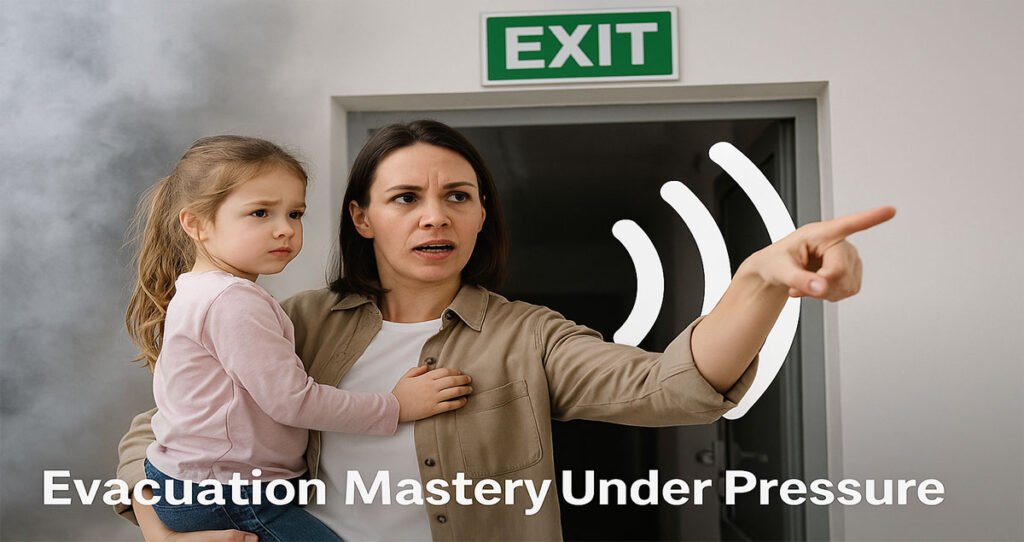
Overcoming the choice loss of motion requires progressive planning, mental practice, and streamlined decision-making systems that decrease cognitive load amid a crisis. Preparing programs that reenact crisis conditions offers assistance to people to hone decision-making under pressure, building certainty and programmed reactions that work successfully when genuine crises happen. This arrangement incorporates understanding individual stretch reactions and creating procedures for keeping up center and clarity amid a crisis.
Training your brain for quick reactions includes customary home crisis management methods, visualization exercises, and push vaccination strategies that prepare people for the physical and emotional demands of crises. Compelling preparing programs incorporate both personal planning and group exercises that reenact practical crisis scenarios, permitting members to hone coordination and communication abilities fundamental for effective departure and crisis reaction.
Route Planning: Your Escape Path to Safety
Different clearing courses for the Maili range incorporate essential and auxiliary choices that account for distinctive fire scenarios, activity conditions, and foundation restrictions. Essential courses ordinarily follow major interstates and built-up roadways, whereas auxiliary courses may incorporate less-traveled streets, walking ways, or alternative transportation strategies that provide choices when essential courses get congested or blocked by fire activity.
Traffic stream administration amid crisis requires coordination between different organizations, clear communication with the open, and the possibility of arranging for different scenarios that may affect clearing adequacy. Fruitful activity administration incorporates pre-positioned activity control staff, electronic message sheets, and alternative directing plans that can be implemented rapidly when clearing orders are issued.
Alternative transportation strategies may end up fundamental when standard departure routes are compromised by fire, traffic congestion, or foundation damage. These options incorporate walking and cycling paths, bikeways, conduit departures, and coordination with open transportation frameworks that can provide clear back during a crisis.
| Route Type | Primary Access | Secondary Options | Estimated Time |
| Highway Routes | Farrington Highway | Lualualei Naval Road | 15-30 minutes |
| Local Roads | Maili Street | Kaukama Road | 20-45 minutes |
| Walking Paths | Coastal Trail | Ridge Access | 45-90 minutes |
| Emergency Routes | Beach Access | Helicopter LZ | Variable |
Essential Evacuation Kit: What to Grab in 60 Seconds
The prioritized thing checklist for crisis flight centers on basic things that back quick survival needs and encourage recuperation after the crisis. The 60-second unit ought to incorporate recognizable proof documents, solutions, crisis contact data, and essential survival supplies that can support people and families during departure periods. This unit ought to be pre-assembled and effectively available to guarantee quick flight when clearing orders are received.
Document assurance methodologies include waterproof capacity, computerized backup frameworks, and different storage areas that guarantee imperative papers and records survive fire occasions and remain open amid recuperation endeavors. Basic reports incorporate protection approaches, identifying proof papers, financial records, and restorative data that encourage crisis administrations and recuperation assistance.
Pet clearing contemplations require arranging for creature transportation, brief shelter plans of action, and veterinary care during expanded clearing periods. Pet departure plans ought to incorporate carriers, chains, nourishment supplies, therapeutic records, and identifying proof labels that guarantee pets can be evacuated securely and reunited with their owners if separated during crises.
Essential 60-Second Evacuation Kit Contents:
- Government-issued distinguishing proof for all family individuals
- Emergency contact list with out-of-area contacts
- Prescription solutions and therapeutic supplies
- Important reports on waterproof holders
- Cash and credit cards for crisis costs
- Phone chargers and versatile communication gadgets
- Basic to begin with help supplies and crisis solutions
- Pet supplies, counting carriers, chains, and nourishment
Communication Protocols That Work
Family Emergency Communication Plans
Contact Pecking Order Foundation makes orderly approaches to family communication amid crises, guaranteeing that data streams effectively and all family members get basic overhauls around security status and departure choices. Compelling chain of command frameworks assign essential and reinforcement contacts, set up communication plans, and give clear conventions for diverse crisis scenarios that may affect ordinary communication methods.
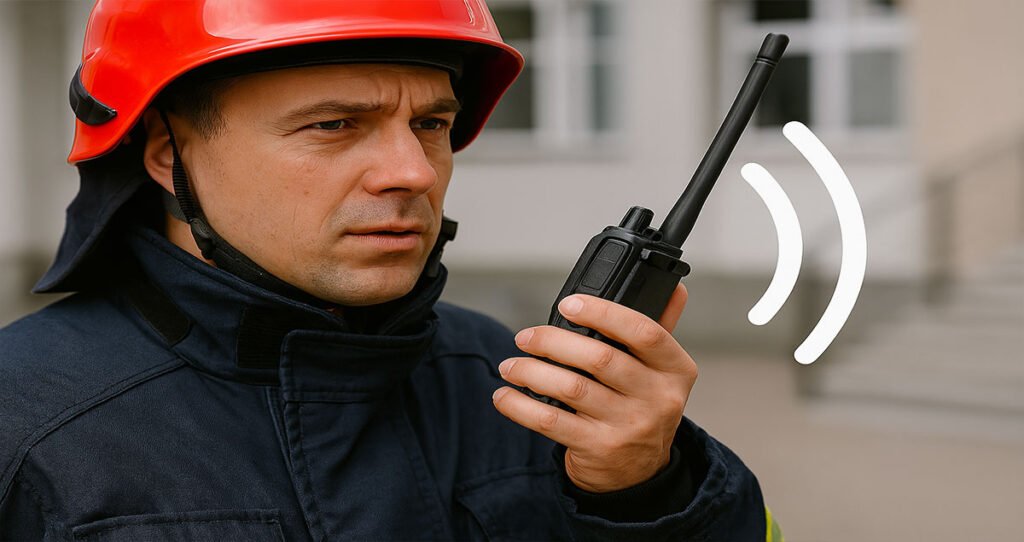
Out-of-state contact coordination leverages the truth that nearby communication frameworks may be compromised during a crisis, whereas far-off regions stay unaffected and can serve as data transfer focuses. Assigned out-of-state contacts ought to be commonplace with family part areas, crisis plans, and neighborhood crisis administrations, empowering them to facilitate data sharing and give help amid expanded crisis periods.
Social media crisis conventions recognize that cutting-edge communication progressively depends on advanced platforms that may provide basic data during a crisis. These conventions ought to incorporate particular stages for family communication, protection settings that ensure individual data, and strategies for sharing area and security data with family members and crisis administrations.
Community Coordination Networks
Neighborhoods observe fire security programs amplify conventional wrongdoing anticipation exercises to incorporate fire security instruction, asset sharing, and coordination during fire crises. These programs make communication systems that empower quick data sharing, shared help, and facilitated response efforts that upgrade person and community security amid fire incidents.
Inter-agency communication enhancements address coordination challenges between fire offices, law enforcement agencies, crisis management organizations, and community organizations that must work together amid fire crises. Successful communication frameworks incorporate standardized conventions, shared communication channels, and customary training exercises that guarantee smooth coordination amid genuine emergencies.
Technology stages for mass communication incorporate crisis warning systems, social media platforms, and specialized applications that empower fast data sharing with large numbers of individuals. These stages ought to provide numerous communication channels, geographic targeting capabilities, and integration with official crisis management frameworks to guarantee that precise, timely data reaches influential communities.
| Communication Method | Reach | Speed | Reliability |
| Emergency Alert System | Regional | Immediate | High |
| Social Media | Variable | Minutes | Moderate |
| Local Radio | Community | Minutes | High |
| Door-to-Door | Neighborhood | Hours | Very High |
Emergency Service Integration
First-responder communication channels require standardized conventions and gear that empower compelling coordination between diverse crisis administrations amid fire occurrences. These channels ought to give clear communication pathways, need to get to for crisis activity, and reinforcement frameworks that keep up communication capabilities when essential frameworks are compromised by fire or other crisis conditions.
Civilian-authority coordination conventions build up clear methods for data sharing between community individuals and crisis administrations, guaranteeing that basic data reaches decision-makers rapidly while avoiding communication framework overburden during a crisis. These conventions ought to incorporate particular contact strategies, data needs, and strategies for reporting crisis conditions or asking for assistance.
Real-time information-sharing frameworks empower nonstop upgrades around fire conditions, clearing orders, and crisis management exercises that offer assistance to community individuals to make educated choices amid advancing crises. Compelling frameworks give different data sources, standard updates, and user-friendly interfaces that guarantee basic data reaches all community fragments, regardless of innovation or communication preferences.
Fire Prevention Through Environmental Management
Defensible Space Creation: Your Property’s Fire Shield
Vegetation administration around structures includes vital planning and supporting homes that make fire-resistant boundaries between natural vegetation and buildings. Compelling faultless space incorporates three particular zones: prompt structure assurance within 30 feet, fuel reduction zones expanding 100 feet from structures, and supervised wildland ranges that diminish fire concentration and spread rates. These zones require particular plant determination, dispersing prerequisites, and upkeep plans that maximize fire security while keeping up tasteful and useful landscape values.
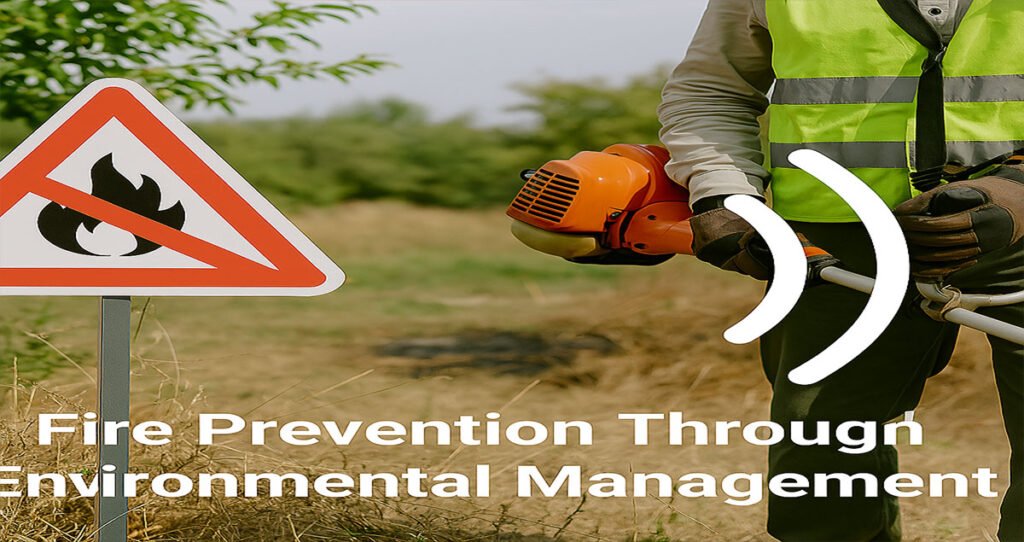
A landscape plan for fire resistance joins plant choice, water system frameworks, and hardscape components that decrease fire risk while supporting property values and natural maintainability. Fire-resistant arranging incorporates local plants with tall dampness, key situations of non-combustible materials, and water system frameworks that can work amid crises to protect structures and vegetation from fire damage.
Maintenance plans for fire security require standard consideration of vegetation management, flotsam, and jetsam evacuation, and foundation support that guarantees fire protection systems stay viable throughout changing seasons and climate conditions. Viable upkeep programs incorporate monthly reviews, regular vegetation management, and yearly framework assessments that identify and address potential fire risks that contribute to fire start or spread.
Community-Wide Prevention Strategies
Collective activity for fire hazard diminishment includes facilitated endeavors between personal property proprietors, community organizations, and neighborhood government offices that address fire dangers at the community level. These endeavors incorporate shared asset programs, facilitated support exercises, and community instruction activities that make comprehensive fire assurance systems extending past personal property boundaries.
Public arrival administration coordination guarantees that fire prevention efforts on private property interface effectively with administration exercises on open lands, making consistent fire security systems that address fire dangers over property boundaries. Successful coordination incorporates joint planning exercises, shared asset assignment, and collaborative upkeep programs that maximize fire assurance benefits for whole communities.
Utility company fire avoidance organizations address electrical foundation dangers that contribute to fire start, including control line support, vegetation management around utility lines, and emergency shutdown methods that decrease fire dangers amid high-risk weather conditions. These associations ought to incorporate normal communication, shared support duties, and facilitated response procedures during fire emergencies.
| Prevention Strategy | Implementation Level | Cost Range | Effectiveness |
| Defensible Space | Individual | $500-$5,000 | High |
| Community Programs | Neighborhood | $2,000-$20,000 | Very High |
| Utility Coordination | Regional | $10,000-$100,000 | High |
| Public Land Management | Government | $50,000-$500,000 | Very High |
Seasonal Preparation: Staying Ahead of Fire Season
Weather checking for fire conditions includes orderly following of temperature, stickiness, wind conditions, and precipitation that impact fire hazard levels all through the year. Successful checking incorporates both official climate benefit data and neighborhood perception systems that give point-by-point data about microclimate conditions that may raise fire dangers in particular areas.
Equipment support and situating guarantee that fire concealment instruments, clearing assets, and crisis supplies stay prepared for prompt utilization when fire conditions are created. Upkeep programs ought to incorporate regular equipment reviews, vital situating of assets, and substitution plans that guarantee unwavering quality during emergencies.
Community instruction and penetration programs give customary openings for inhabitants to hone fire security methods, learn about modern fire dangers, and keep up readiness abilities all through the year. Successful programs incorporate regular security introductions, clearing drills, and hands-on preparing openings that construct community-wide fire security capabilities and keep up mindfulness of fire dangers and anticipation strategies.
Technology Revolution: Modern Tools for Fire Safety
Satellite Monitoring and AI Fire Detection
Cutting-edge innovation in fire anticipation incorporates progressed adj. frameworks, artificial intelligence algorithms, and computerized location systems that can recognize fire conditions and track fire behavior with unprecedented exactness and speed. These advances give early warning capabilities that amplify distant past conventional ground-based location strategies, advertising comprehensive observation of huge zones with negligible human intervention requirements.
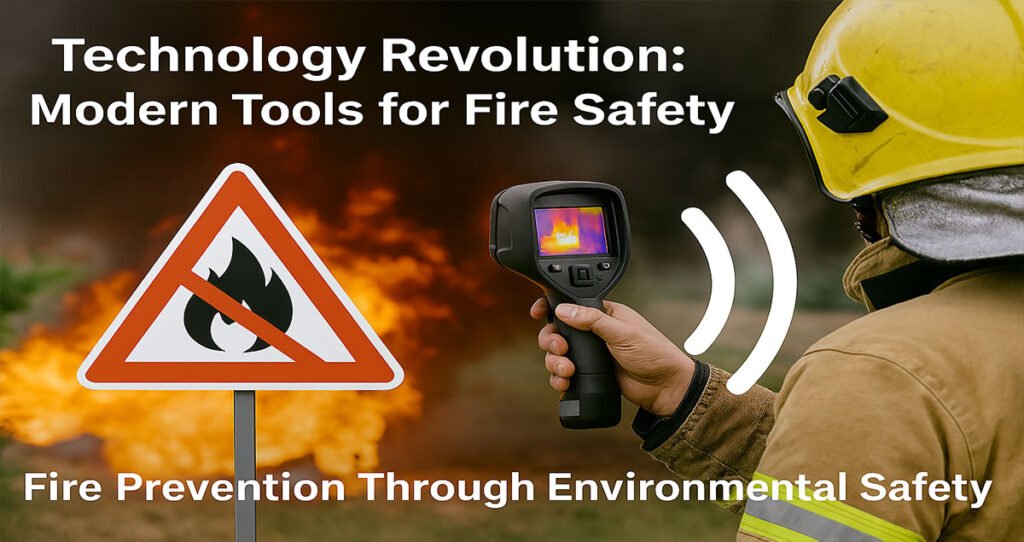
Real-time fire behavior modeling utilizes advanced computer calculations and natural information to anticipate fire spread designs, concentrated changes, and potential impact ranges that offer assistance to crisis directors to make educated choices, almost as asset assignment and departure timing. These models consolidate climate information, territory data, and fuel characteristics to give detailed forecasts around fire behavior under different scenarios.
Predictive analytics for risk evaluation combines authentic fire information, natural conditions, and human action designs to recognize ranges and periods with heightened fire risk, empowering proactive avoidance measures and asset situating that can prevent fire occurrences or minimize their effect when they occur.
Mobile Applications for Personal Safety
User-friendly apps for fire observing give people access to real-time fire data, climate information, and crisis alarms through smartphone and tablet interfaces that make fire security data available to anybody with a versatile gadget. These applications ought to incorporate customizable alarm settings, offline functionality, and integration with official crisis management systems.
GPS-based clearing helps utilize area administrations and mapping innovation to give personalized clearing course suggestions, real-time activity data, and alternative directing alternatives that offer assistance to people to explore securely amid fire crises. These frameworks ought to account for current fire conditions, street closures, and traffic congestion to give ideal clearing guidance.
Emergency contact computerization empowers fast notice of family members, crisis administrations, and other important contacts when fire crises happen, diminishing the communication burden on people amid high-stress circumstances while guaranteeing that important individuals get convenient data about security status and location.
Smart Home Integration for Fire Protection
Automated frameworks for fire location incorporate keen smoke locators, warm sensors, and natural monitoring devices that can detect fire conditions and automatically inform crisis administrations while giving early warning to tenants. These frameworks ought to incorporate battery reinforcement, remote networks, and integration with domestic security and automation frameworks for comprehensive protection.
Remote checking capabilities empower property proprietors to screen fire conditions and security frameworks from remote areas, giving peace of mind amid travel and empowering quick reaction to fire alarms even when not shown at the property. Further checking ought to incorporate video reconnaissance, natural sensors, and communication frameworks that give comprehensive data approximately property conditions.
Integration with crisis administrations incorporates programmed notice frameworks that can contact fire offices, crisis restorative administrations, and others to initiate responders when fire conditions are recognized, giving speedier reaction times and more detailed data about fire areas and conditions than conventional alert frameworks.
Community Success Stories: When Preparation Pays Off
Maili Residents Who Saved Their Homes
Real-life illustrations of effective fire defense illustrate how legitimate arrangement, speedy decision-making, and community participation can ensure property and lives amid fire crises. These victory stories incorporate families who actualized faultless space techniques, kept up crisis supplies, and executed departure plans that empowered them to ensure their homes and guarantee family security during fire incidents.
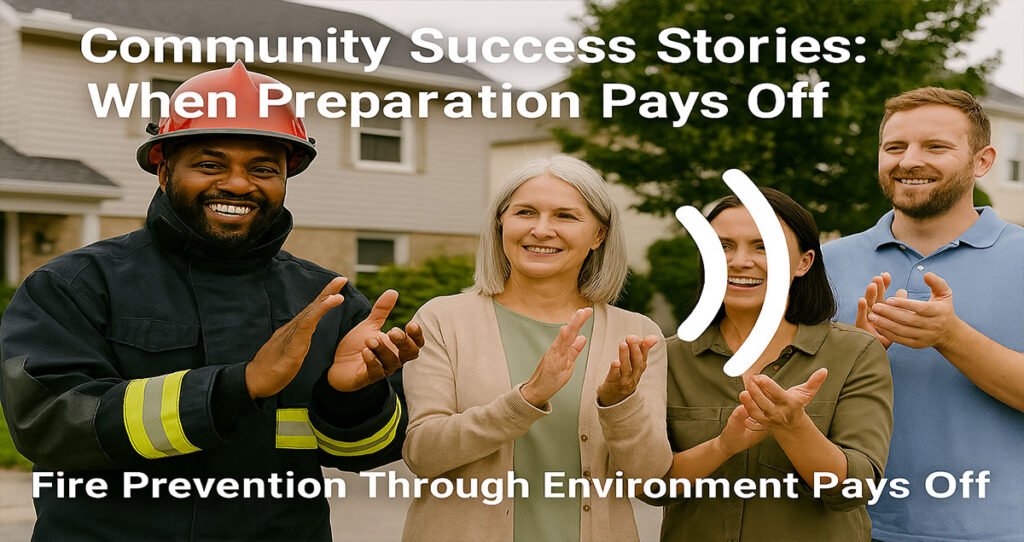
Preparation methodologies that worked included particular activities taken by successful fire survivors, such as vegetation management, crisis unit organization, clearing course planning, and communication framework foundation, which contributed to positive results amid fire crises. These methodologies give common cases that other community individuals can adjust to their circumstances and circumstances.
Lessons learned from survivors incorporate experiences around what worked well, what may have progressed, and what they would do in an unexpected way amid future fire crises. These lessons give profitable direction for other community individuals planning for fire dangers and offer assistance in recognizing effective methodologies for fire security planning and response.
Neighborhood Cooperation That Prevented Disasters
Community organization victory stories illustrate how neighborhoods working together can accomplish fire assurance that surpasses what people can accomplish alone. These illustrations incorporate facilitated vegetation management, shared asset programs, and communication systems that improve fire security for whole neighborhoods amid fire emergencies.
Collaborative fire avoidance endeavors incorporate joint exercises between neighbors, such as shared gear buys, facilitated upkeep exercises, and group training programs that construct community-wide fire security capabilities while decreasing personal costs and labor requirements. These collaborative endeavors make more grounded, stronger communities that can better ensure themselves amid fire emergencies.
Mutual help amid a crisis illustrates how neighbors make a difference. Neighbors can give basic support amid fire episodes, including departure help, asset sharing, and emotional support that makes a difference in community individuals adapting to fire crises and recovering more effectively afterward.
Action Plan: Your Fire Safety Implementation Guide
30-Day Fire Safety Transformation
Week-by-week execution plan gives an organized approach to building comprehensive fire security capabilities within one month, breaking down complex fire security necessities into sensible week-by-week objectives that people and families can finish without overpowering their typical schedules. The to begin with week centers on evaluation and planning, followed by planning exercises, preparing workouts, and framework testing that construct total fire security programs.
Prioritized activity distinguishes the most basic fire security measures that give the most extreme assurance benefits, making a difference when people center their introductory endeavors on exercises that will make the greatest contrast in their fire security readiness. High-priority things incorporate departure planning, crisis unit together, and a communication framework foundation that forms the establishment of viable fire security programs.
Progress following strategies empowers people to screen their fire security enhancement endeavors, recognize regions requiring extra consideration, and maintain inspiration through the use of training. Successful following incorporates checklists, calendar updates, and intermittent assessments that offer assistance to keep up force and guarantee the completion of fire security goals.
| Week | Primary Focus | Key Activities | Success Metrics |
| Week 1 | Assessment | Risk evaluation, plan development | Completed assessment |
| Week 2 | Preparation | Kit assembly, route planning | Emergency supplies ready |
| Week 3 | Training | Evacuation practice, communication | Successful drill completion |
| Week 4 | Integration | System testing, community connections | Full system operational |
Monthly Fire Safety Maintenance
Regular appraisal conventions guarantee that fire security frameworks stay successful through changing seasons, climate conditions, and family circumstances that may affect fire security readiness. Month-to-month appraisals ought to incorporate gear reviews, arrange upgrades, and prepare refreshers that keep fire security capabilities at ideal levels.
Equipment checks and upgrades incorporate a precise review of crisis supplies, communication gadgets, and fire concealment apparatuses that guarantee all fire security gear remains functional and prepared for prompt utilization when required. Standard support anticipates hardware disappointments amid crises and recognizes substitution needs some time recently they become critical.
Community engagement exercises give opportunities to keep up associations with neighbors, take an interest in community fire safety programs, and remain educated about nearby fire dangers and prevention exercises that may affect personal and family fire safety planning. Standard community cooperation fortifies neighborhood fire security systems and gives access to assets and data that improve personal fire security efforts.
Annual Fire Safety Evaluation
A comprehensive audit of security measures gives a yearly opportunity to assess fire security program adequacy, identify enhancement opportunities, and upgrade plans based on changing conditions, modern innovations, and lessons learned from fire occurrences in the community or locale. Yearly audits ought to incorporate all viewpoints of fire security planning, from person planning to community coordination.
Plan upgrades based on unused dangers join data, almost changing fire dangers, advanced security innovations, and lessons learned from later fire episodes that may require adjustments to existing fire security plans. Standard upgrades guarantee that fire security programs stay current and compelling as conditions change over time.
Community-wide security changes deliver opportunities to contribute to broader fire security endeavors that advantage entire neighborhoods and communities, tallying intrigued in orchestrating shapes, volunteer work out, and educator programs that strengthen community fire adaptability and make more secure circumstances for everybody.
Expert Insights: Professional Perspectives on Fire Safety
Fire Chief Recommendations for Maili Area
The professional exhortation from neighborhood fire specialists gives master direction specific to Maili range fire dangers, reaction capabilities, and avoidance techniques that reflect profound information of neighborhood conditions and broad involvement with fire episodes in the locale. Fire chief proposals incorporate particular activities that inhabitants can take to improve their fire security, as well as broader community activities that would improve general fire protection.
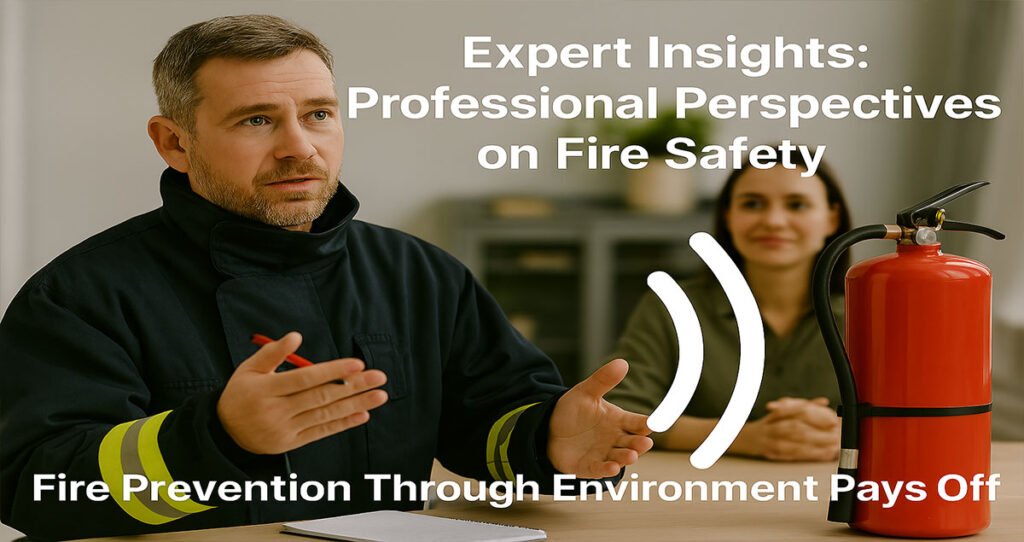
Resource assignment bits of knowledge uncover how fire divisions prioritize reaction exercises, position gear, and faculty, and coordinate with other organizations amid fire crises. Understanding these asset assignment choices makes a difference in community individuals making educated choices about their fire security arrangements and how their activities can hinder crisis response efforts.
Community-specific security proposals address the interesting characteristics of the Maili range, including geographic highlights, framework confinements, and statistical components that impact fire security planning and response techniques. These proposals focus on a direction that addresses neighborhood conditions or maybe than bland fire security exhortation that may not apply to particular community circumstances.
Emergency Management Best Practices
Industry guidelines for fire readiness give benchmarks for assessing fire security programs and recognizing areas where changes are required to meet proficient measures for crisis readiness. These guidelines incorporate particular prerequisites for clearing arranging, communication frameworks, and asset management that shape the premise of successful fire security programs.
Lessons from other fire-prone locales offer bits of knowledge from communities that have effectively tended to fire security challenges comparable to those confronting Maili region inhabitants. These lessons incorporate effective techniques, common botches to maintain a strategic distance from, and inventive approaches that have demonstrated success in comparative geographic and statistical conditions.
Future patterns in fire security incorporate developing advances, advancing best practices, and changing risk factors that may affect fire security planning and design requirements. Understanding these patterns makes a difference to people and communities planning for future fire security challenges while taking advantage of unused openings for moving forward with fire assurance and crisis response.
Post-Fire Recovery and Resilience Building
The conclusion of the firefight is the start of the recuperation trip. This last lesson centers on exploring the consequences securely and modifying a more grounded, more fire-resilient community. The activities taken in the hours, days, and months after a fire are as basic as the arrangements made some time ago.
Immediate Post-Fire Safety Protocols
Once the blazes are quenched and authorities grant the “all-clear” to return, the environment remains dangerous. Surging back without safeguards can lead to damage or illness.
- Hazard Appraisal After Fire Control: Your property is presently in a dynamic danger zone. See smoldering fiery remains, downed control lines, shaky trees with burned-out roots, and weakened structures. A proficient appraisal is regularly fundamental time when a building can be regarded as secure to enter. Accept all utility lines (electric, gas, water) that are damaged and contact suppliers for a security inspection.
- Air Quality Checking and Security: The discussion will be filled with fine-particulate fiery remains and possibly poisonous substances from burned materials. These can cause extreme respiratory issues. Utilize N95 or P100 masks when outside. Keep windows and entryways closed to secure indoor discussion quality and utilize discuss purifiers with HEPA channels if possible. Remain educated through open wellbeing advisories.
- Property Harm Assessment Strategies: Sometime recently, you moved or cleaned anything; record everything. Take broad photographs and recordings of the harm from different points. Make a nitty gritty stock of misplaced or harmed things. This documentation is non-negotiable for protection claims and potential catastrophe assistance.
Long-Term Community Recovery Planning
Recovery is a marathon, not a sprint. A key, forward-thinking approach guarantees that the community doesn’t just revamp, but builds back better.
- Rebuilding Procedures for Fire-Resistant Communities: This is an opportunity to actualize more secure building measures. Utilize fire-resistant materials for material and siding (metal, tile, stucco), introduce double-paned windows, and plan scenes that coordinate flawless space from the ground up. Community planning can moreover address chokepoints in clearing courses and make more “fire breaks” with greenbelts.
- Insurance Coordination and Documentation: The protections prepared are complex and requesting. Keep a point-by-point log of each discussion with your protection agent, including the date, time, and rundown of the talk. Keep all receipts for living costs, repairs, and replacement items. Be determined and organized to guarantee you get the full benefits you are entitled to.
- Psychological Back for Fire Survivors: The injury of a fire, the misfortune of property, and the process of recovery take a noteworthy mental toll. Communities must prioritize mental well-being administrations, backlines, and counseling for inhabitants and to begin with responders. Recognizing and treating this “undetectable harm” is basic for genuine, long-term community healing.
| Recovery Phase | Duration | Primary Focus | Key Activities |
| Immediate | 0-72 hours | Safety & Assessment | Hazard assessment, securing property, documenting damage, and meeting basic needs. |
| Short-term | 1-4 weeks | Stabilization | Filing insurance claims, arranging temporary housing, and utility restoration. |
| Medium-term | 1-6 months | Rebuilding | Debris removal, permitting, starting construction, and financial planning. |
| Long-term | 6+ months | Resilience | Community planning, psychological support, and updating safety protocols. |
Resilience Building: Learning from Each Incident
A strong community doesn’t fairly bounce back; it bounces forward. Each fire occurrence, no matter the scale, is a source of important data.
- Adaptive Administration Approaches: Fire security plans ought to be living records. After each occurrence, community pioneers and crisis administrations must conduct after-action audits to distinguish what worked and what didn’t. This input circle permits the persistent refinement of departure courses, communication strategies, and reaction tactics.
- Community Input Integration: The individuals most influenced by the fire are regularly the most profitable specialists. Make formal channels—like town corridors, studies, and community admonitory boards—to coordinate citizen input into official planning. Their on-the-ground encounters can uncover daze spots that organizers might miss.
- Continuous Enhancement in Fire Security: Strength is a progressing commitment. It implies contributing to unused advances, routinely overhauling community-wide fire drills, and cultivating a lasting culture of readiness. The objective is to guarantee the lessons from the Maili fires of 2024 are not overlooked but are woven into the exceptional texture of the community’s identity.
Conclusion: From Knowledge to Action – Securing Maili’s Future
The Maili Fire timeline is more than a record of past occasions; it is a diagram for future survival. The smoke has cleared, but the lessons stay, stark and capable. We have seen how heaven can be debilitated in a moment, but we have also seen how planning, communication, and community activity can shape an unbreakable shield against disaster.
The five basic lessons—Early Caution, Departure Authority, Clear Communication, Natural Administration, and Strong Recovery—are not hypothetical concepts. They demonstrated life-saving methodologies fashioned in the warmth of genuine crises. From downloading an alarm app to clearing dry brush from your yard, every single activity you take contributes to a more grounded, more secure Maili.
The control to ensure our homes and our loved ones does not rest exclusively with the fire division. It rests in our hands, in our neighborhoods, and in our collective commitment to turn information into activity. Let the bequest of the 2024 fires be one of transformation—a turning point where the community saddles its involvement to construct a future where it is not fairly arranged for fire, but strong to it. Your travel to fire security dominance begins today.
Frequently Asked Questions (FAQ) About Fire Safety
What are the single most critical security lessons from the Maili fire incidents?
- The Maili fire timeline highlights five basic, life-saving lessons:
- Implement Early Caution Frameworks: Utilize alarm apps and know the natural signs of fire danger.
- Master Clearing: Have different arranged courses and a “go-kit” prepared to take off at a moment’s notice.
- Establish Communication Conventions: An out-of-state contact phone arrangement made with the family should be in a crisis setting.
- Manage Your Environment: Make a faultless space around your property by clearing combustible vegetation.
- Plan for Recuperation: Get the steps for post-fire security and modifying resilience.
I need to be arranged, but it feels overpowering. What is the first thing I ought to do today?
- The most impactful thing to begin with is to make your 60-Second Clearing Pack. Assemble basic things like recognizable proof, solutions, vital archives (in a waterproof holder), cash, and chargers. Having this pack pre-packed and open evacuates a major point of stress and delay amid a genuine clearing arrangement, guaranteeing you can take off rapidly and safely.
The article notices “faultless space.” Why is this so vital, and is it my responsibility?
- Defensible space is the barrier area you create, which forms a gap between your domestic place and the vegetative area around it. It is seemingly the most successful way to secure your property, as it can moderate or indeed halt a fire from coming to your house. Whereas making this space on your property is your obligation, its viability increases when your neighbors do it as well. This makes a community-wide firebreak, anticipating fire from effectively bouncing from one domestic to the next and making the whole neighborhood safer.
How can I utilize innovation to make strides in my family’s fire safety?
- Modern innovation is an effective partner. At least, you should:
- Download Crisis Alarm Apps: Empower the government and climate cautions on your smartphone for real-time notifications.
- Use GPS for Departure: Outline apps can give real-time activity information and alternative routes if your essential route is blocked.
- Digitize Archives: Filter vital archives and store them in a secure cloud to access from anywhere.
After a fire is contained, what are the greatest covered-up perils I need to look out for?
- Even after the blazes are gone, the range remains unsafe. The essential perils are:
- Unpredictable buildings and land: Burned-down trees will fall without prior indication, and buildings will become weakened.
- Poor Discuss Quality: Fiery remains and harmful particulates in the discussion can cause genuine respiratory issues. Wear an N95 or P100 mask.
- Utility Risks: Accept all control lines are live, and be mindful of potential gas spills. Do not go back to your property until experts have considered it a safe place.

